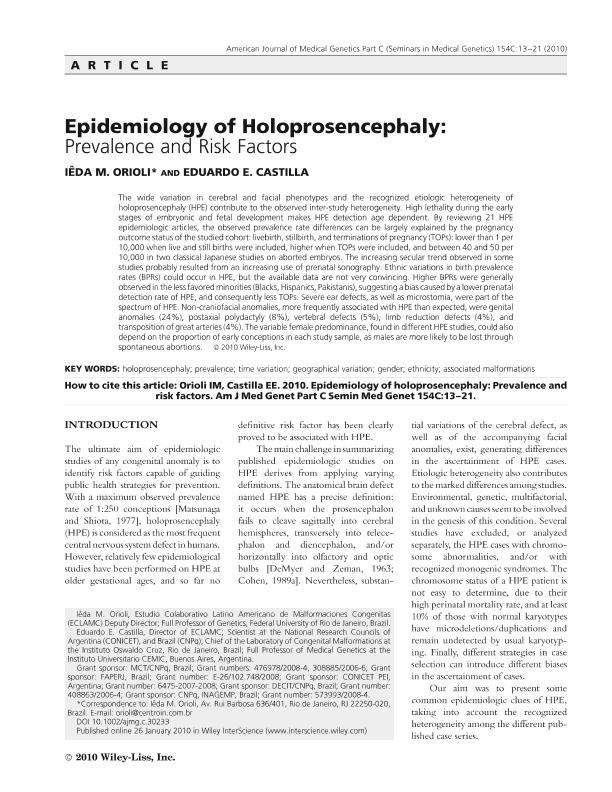Mostrar el registro sencillo del ítem
dc.contributor.author
Orioli, Iêda M.
dc.contributor.author
Castilla, Eduardo Enrique

dc.date.available
2018-07-31T19:01:27Z
dc.date.issued
2010-02
dc.identifier.citation
Orioli, Iêda M.; Castilla, Eduardo Enrique; Epidemiology of holoprosencephaly: Prevalence and risk factors; Wiley-liss, Div John Wiley & Sons Inc; American Journal Of Medical Genetics Part C-seminars In Medical Genetics; 154; 1; 2-2010; 13-21
dc.identifier.issn
1552-4868
dc.identifier.uri
http://hdl.handle.net/11336/53643
dc.description.abstract
The wide variation in cerebral and facial phenotypes and the recognized etiologic heterogeneity of holoprosencephaly (HPE) contribute to the observed inter-study heterogeneity. High lethality during the early stages of embryonic and fetal development makes HPE detection age dependent. By reviewing 21 HPE epidemiologic articles, the observed prevalence rate differences can be largely explained by the pregnancy outcome status of the studied cohort: livebirth, stillbirth, and terminations of pregnancy (TOPs): lower than 1 per 10,000 when live and still births were included, higher when TOPs were included, and between 40 and 50 per 10,000 in two classical Japanese studies on aborted embryos. The increasing secular trend observed in some studies probably resulted from an increasing use of prenatal sonography. Ethnic variations in birth prevalence rates (BPRs) could occur in HPE, but the available data are not very convincing. Higher BPRs were generally observed in the less favored minorities (Blacks, Hispanics, Pakistanis), suggesting a bias caused by a lower prenatal detection rate of HPE, and consequently less TOPs. Severe ear defects, as well as microstomia, were part of the spectrum of HPE. Non-craniofacial anomalies, more frequently associated with HPE than expected, were genital anomalies (24%), postaxial polydactyly (8%), vertebral defects (5%), limb reduction defects (4%), and transposition of great arteries (4%). The variable female predominance, found in different HPE studies, could also depend on the proportion of early conceptions in each study sample, as males are more likely to be lost through spontaneous abortions. © 2010 Wiley-Liss, Inc.
dc.format
application/pdf
dc.language.iso
eng
dc.publisher
Wiley-liss, Div John Wiley & Sons Inc

dc.rights
info:eu-repo/semantics/openAccess
dc.rights.uri
https://creativecommons.org/licenses/by-nc-sa/2.5/ar/
dc.subject
Associated Malformations
dc.subject
Ethnicity
dc.subject
Gender
dc.subject
Geographical Variation
dc.subject
Holoprosencephaly
dc.subject
Prevalence
dc.subject
Time Variation
dc.subject.classification
Salud Ocupacional

dc.subject.classification
Ciencias de la Salud

dc.subject.classification
CIENCIAS MÉDICAS Y DE LA SALUD

dc.title
Epidemiology of holoprosencephaly: Prevalence and risk factors
dc.type
info:eu-repo/semantics/article
dc.type
info:ar-repo/semantics/artículo
dc.type
info:eu-repo/semantics/publishedVersion
dc.date.updated
2018-07-30T15:43:07Z
dc.journal.volume
154
dc.journal.number
1
dc.journal.pagination
13-21
dc.journal.pais
Estados Unidos

dc.journal.ciudad
Hoboken
dc.description.fil
Fil: Orioli, Iêda M.. Universidade Federal do Rio de Janeiro; Brasil
dc.description.fil
Fil: Castilla, Eduardo Enrique. Consejo Nacional de Investigaciones Científicas y Técnicas; Argentina. Instituto Oswaldo Cruz; Brasil. Centro de Educación Médica e Investigaciones Clínicas “Norberto Quirno”; Argentina
dc.journal.title
American Journal Of Medical Genetics Part C-seminars In Medical Genetics

dc.relation.alternativeid
info:eu-repo/semantics/altIdentifier/doi/https://dx.doi.org/10.1002/ajmg.c.30233
dc.relation.alternativeid
info:eu-repo/semantics/altIdentifier/url/https://onlinelibrary.wiley.com/doi/abs/10.1002/ajmg.c.30233
Archivos asociados
